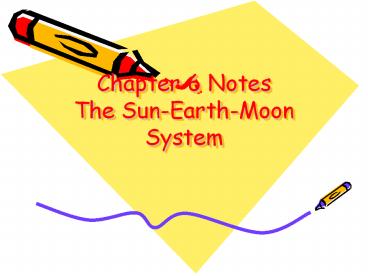Chapter 6 Notes The Sun-Earth-Moon System PowerPoint PPT Presentation
Title: Chapter 6 Notes The Sun-Earth-Moon System
1
Chapter 6 NotesThe Sun-Earth-Moon System
2
Section 1Earths Motion
- Astronomy- the study of the moon, stars, and
other objects in space. - Axis- the imaginary line that passes through
Earths center and the North and South poles. - The tilt of the earths axis is 23.5 degrees
- The Earths axis always points in the same
direction.
3
- Rotation- the spinning of the earth on its axis.
- The earth rotates on its axis one time in a 24
hour span (DAY) - The earths rotation on its axis causes night and
day. - (see rotation pictures)
4
- Revolution- the movement of an object around
another object (YEAR) - It takes the earth 365.25 days to make one
revolution around the sun.
5
- Orbit- the earths path as it travels around the
sun. - Earth has seasons because its axis is tilted as
it moves around the sun - When the northern hemisphere points towards the
sun, we will experience summer. - When the southern hemisphere points towards the
sun, we will experience winter.
6
- Solstice- Either the northern or southern
hemisphere is pointing towards the sun - Equinox- Neither end of the Earths axis is
tilted towards the sun (equal day and night)
7
Section 2Phases, Eclipses, and Tides
- The moon makes one rotation in 27.3 days (DAY)
- The moon makes one revolution in 27.3 days
(YEAR) - The moons day and year are the same.
Because of this, we see the same side of the moon
all the time.
8
- The phases of the moon depend on how much of the
lighted side of the moon can be seen from Earth. - When the moons shadow hits Earth or Earths
shadow hits the moon, an eclipse occurs.
9
- Lunar Eclipse- SUN-EARTH-MOON
- Only occur during full moon
- Solar Eclipse- SUN-MOON-EARTH
- Only occur during new moon.
10
- Tides- The force of gravity between the earth and
moon and between the sun and moon affecting our
oceans and causing high and low tides. - Spring Tide- sun and moon are in line
- Neap Tide- Sun and moon are at a right angle to
the earth (see pictures)
11
- Phases of the Moon
- 1. New Moon
- 2. Waxing Crescent
- 3. First Quarter
- 4. Waxing Gibbous
- 5. Full Moon
- 6. Waning Gibbous
- 7. Third Quarter
- 8. Waning Crescent
PowerShow.com is a leading presentation sharing website. It has millions of presentations already uploaded and available with 1,000s more being uploaded by its users every day. Whatever your area of interest, here you’ll be able to find and view presentations you’ll love and possibly download. And, best of all, it is completely free and easy to use.
You might even have a presentation you’d like to share with others. If so, just upload it to PowerShow.com. We’ll convert it to an HTML5 slideshow that includes all the media types you’ve already added: audio, video, music, pictures, animations and transition effects. Then you can share it with your target audience as well as PowerShow.com’s millions of monthly visitors. And, again, it’s all free.
About the Developers
PowerShow.com is brought to you by CrystalGraphics, the award-winning developer and market-leading publisher of rich-media enhancement products for presentations. Our product offerings include millions of PowerPoint templates, diagrams, animated 3D characters and more.

